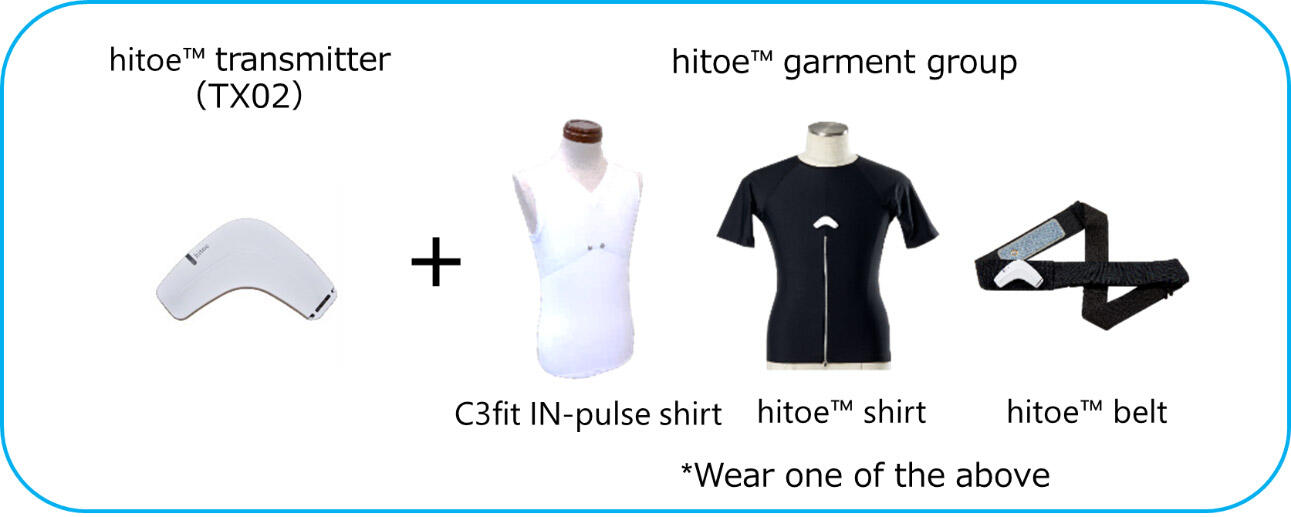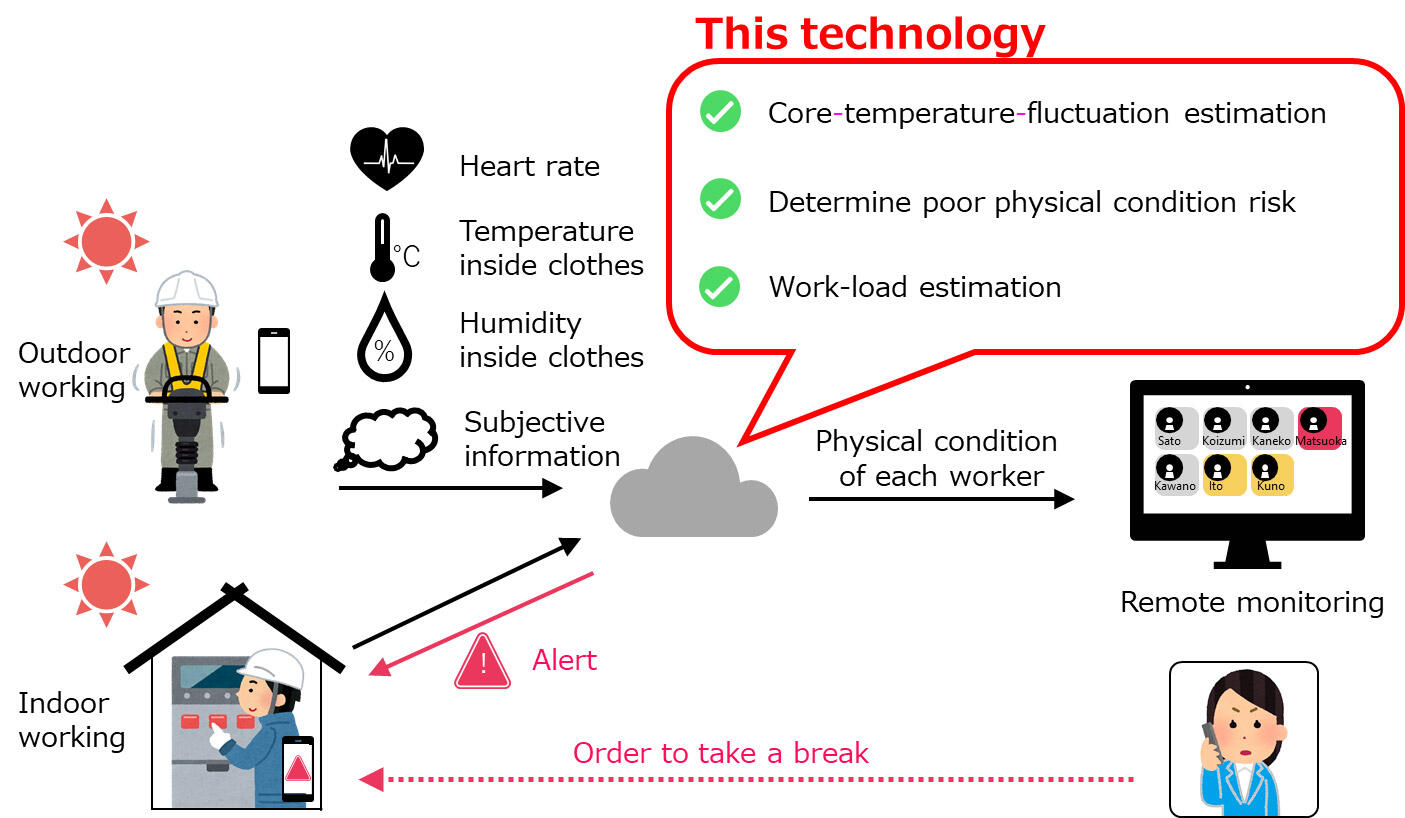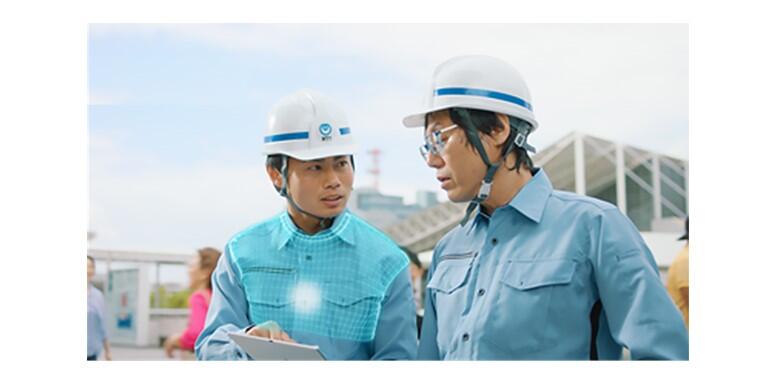Microsoft ends support for Internet Explorer on June 16, 2022.
We recommend using one of the browsers listed below.
- Microsoft Edge(Latest version)
- Mozilla Firefox(Latest version)
- Google Chrome(Latest version)
- Apple Safari(Latest version)
Please contact your browser provider for download and installation instructions.
November 13, 2020
NTT
Nagoya Institute of Technology
Yokohama National University
Shigakkan University
Determination and alert method of the risk of poor physical condition due to heat based on thermal physiology: Aiming for safety and security of workers working in a hot environment
NTT, Nagoya Institute of Technology, Yokohama National University and Shigakkan University have developed a technology for real time determination and alert of the risk of poor physical condition due to heat through joint clinical experiments. The risk of poor physical condition due to heat is determined by subjective information and vital data including body-core-temperature fluctuations, which are estimated by a method newly developed by the joint research with Nagoya Institute of Technology. The alert algorithm is newly constructed on the basis of the knowledge obtained from the joint experiment and from thermal physiology.
To verify the usefulness of our technology at work sites, we conducted a verification experiment targeting construction workers wearing wearable biological/environmental sensors※1from August to September 2020 with the cooperation of NTT EAST. Based on the knowledge obtained in this experiment, we aim to utilize our technology for the physical condition management of workers in a hot environment.
1. Background
The number of emergency transports and deaths due to heat stroke has increased, and reducing them has become a major social issue in Japan. According to a survey by the Fire and Disaster Management Agency, 64,770 people were transported by emergency due to heat stroke from June 1st to October 4th, 2020. According to the Ministry of Health, Labor and Welfare (MHLW), there were 829 casualties (death and leave of absence 4 days or more) due to heat stroke in the workplace in 2019, of which 25 died. MHLW has published guidelines and manuals for heat-stroke prevention measures in the workplace※2.
NTT Device Innovation Center has been engaged in research and development to realize "appropriate operation management by estimating the work load of each worker" and "avoiding the risk of poor physical condition by estimating heat stress" using wearable biological/environmental sensors to solve such social issues and create more comfortable work sites.
2. Determination and alert of the risk of poor physical condition due to heat
We developed a technology for estimating core-temperature fluctuations※3, which are one of indicators of poor physical condition in hot environments, in real time during activity through joint research with Nagoya Institute of Technology. In a joint clinical experiment※4between NTT, Yokohama National University, Shigakkan University, and Nagoya Institute of Technology, we confirmed the applicability of the core-temperature-fluctuation estimation logic using the artificial weather room of Shigakkan University. And we also constructed an algorithm that determines the overall risk of poor physical condition from vital data including the core-temperature fluctuations and issues an alert in the case of high risk based on the experimental results and the theory of thermal physiology.
3. Verification in the workplace
To verify the usefulness of our technology at work sites, we conducted a verification experiment※5targeting construction workers (834 man-days for 49 individuals) in the Tokyo, Kanagawa, and Hokkaido regions from August to September 2020 with the cooperation of NTT EAST. We implemented our core-temperature-fluctuation-estimation technology, algorithm for determining the risk of poor physical condition, and work-load-estimation technique※6as smartphone applications and built a demo system that remotely monitors the physical condition of each worker wearing wearable biological/environmental sensors via the cloud (this demo system is not for medical use). Alerts are sent to workers who were determined to be at high risk.
 Fig. 1. Wearable biological/environmental sensors.
Fig. 1. Wearable biological/environmental sensors.
 Fig. 2. Schematic of verification experiment.
Fig. 2. Schematic of verification experiment.
To confirm the usefulness of the core-temperature fluctuation-estimation technology and work-load estimation technique at the work site, we evaluated the relationship between the subjective information (warm/cold feeling, rate of perceived exertion) obtained from the workers and the estimation results. We confirmed that there is a correlation between the estimated core-temperature fluctuation and warm/cold feeling and between the estimated work load and the rate of perceived exertion. These results indicate the possibility of visualizing the subjectivity of workers without using questionnaires and the usefulness of core-temperature fluctuation estimation and workload estimation based on wearable biological/environmental sensor data.
Risk cases were detected during the verification by the algorithm for determining the risk of poor physical condition. Alerts were sent to remotely monitoring managers and workers. Since no serious cases of poor physical condition, such as heat stroke, occurred during this verification experiment, we consider our technology useful.
4. Summary
To make work sites more comfortable, we developed a physical-condition-management technology that involves wearable sensors and verified it at a work site. We will continue to deepen our knowledge by introducing our technology at more work sites and promote further improvements.
 Fig. 3. Image of applying this technology to workers.
Fig. 3. Image of applying this technology to workers.
※1Wearable biological/environmental sensor consists of transmitter (TX02) commercialized by NTT TechnoCross Corp. based on the wearable biological/environmental sensor technology (https://group.ntt/jp/newsrelease/2019/11/08/191108a.html) researched and developed by NTT Device Innovation Centor, and hitoe garment group including hitoe shirt and hitoe belt by Toray Industries and C3fit IN-pulse shirt by Goldwin Inc. This sensor measures microelectric waveform generated by the heartbeat, temperature/humidity inside clothes, and upper body acceleration/angular-velocity. And this sensor analyzes feature quantities such as heart rate, R-R intervals, number of steps, and upper body tilt. This sensor is not a medical device.
hitoeTM: The functional fabric hitoe is a fiber material jointly developed by Toray Industries, Inc. and Nippon Telegraph and Telephone Corporation, and is a trademark of the two companies.
※2https://www.mhlw.go.jp/stf/seisakunitsuite/bunya/0000116133.html
※3Japanese Journal of Biometeorology 56(3): S32-S32, 2019.
※4Shigakkan University Research Ethics Review Committee No.124.
※5The Japanese Society for Wellbeing Science and Assistive Ethics Review Committee No. 286.
Information is current as of the date of issue of the individual press release.
Please be advised that information may be outdated after that point.
NTT STORY
WEB media that thinks about the future with NTT










